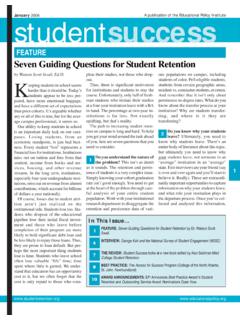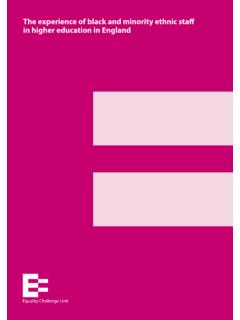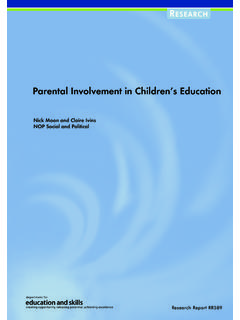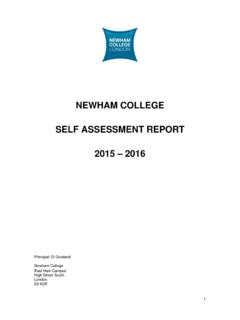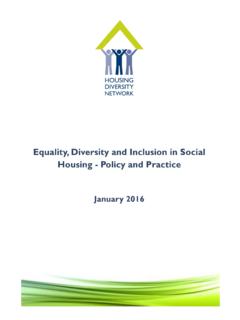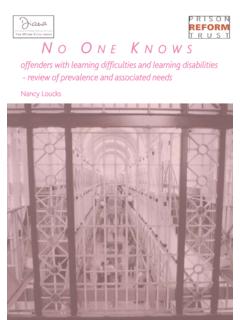Transcription of Retaining Minority Students in Higher Education
1 ASHE-ERIC Higher Education Report: Volume 30, Number 2 Adrianna J. Kezar, Series EditorRetaining Minority Students inHigher EducationA Framework for SuccessWatson Scott Swail,with Kenneth E. Redd and Laura W. 11/14/03 12:50 PM Page iRetaining Minority Students in Higher Education : A Framework for SuccessWatson Scott Swail, with Kenneth E. Redd and Laura W. PernaASHE-ERIC Higher Education Report: Volume 30, Number 2 Adrianna J. Kezar, Series EditorThis publication was prepared partially with funding from the Office ofEducational Research and Improvement, Department of Education , undercontract no.
2 ED-99-00-0036. The opinions expressed in this report do notnecessarily reflect the positions or policies of OERI or the 2003 Wiley Periodicals, Inc., A Wiley Company. All rights or translation of any part of this work beyond that permitted bySections 107 or 108 of the 1976 United States Copyright Act without permissionof the copyright owner is unlawful. Requests for permission or further informationshould be addressed to the Permissions Department, c/o John Wiley & Sons,Inc., 111 River St., Hoboken, NJ 07030; (201) 748-8789, fax (201) 748-6326, 0884-0040electronic ISSN 1536-0709 ISBN 0-7879-7247-9 The ASHE-ERIC Higher Education Reportis part of the Jossey-Bass Higherand Adult Education Series and is published six times a year by Wiley SubscriptionServices, Inc.
3 , A Wiley Company, at Jossey-Bass, 989 Market Street, San Francisco,California subscription information, see the Back Issue/Subscription Order Formin the back of this FOR PROPOSALS:Prospective authors are strongly encouraged to contactAdrianna Kezar at the University of Southern California, Waite Phillips Hall 703C,Los Angeles, CA 90089, or See About the ASHE-ERIC HigherEducation Report Series in the back of this the Jossey-Bass Web site at in the United States of America on acid-free recycled 11/14/03 12:50 PM Page iiiiiRetaining Minority Students in Higher EducationAdvisory BoardThe ASHE-ERIC Higher Education Report Series is sponsored by theAssociation for the Study of Higher Education (ASHE)
4 , which provides aneditorial advisory board of ASHE FeldmanSUNY at Stony BrookAnna OrtizMichigan State UniversityJames FairweatherMichigan State UniversityJerlando JacksonUniversity of WisconsinElaine El-KhawasGeorge Washington UniversityMelissa AndersonUniversity of MinnesotaDoug TomaUniversity of PennsylvaniaAmy MetcalfeUniversity of ArizonaCarol ColbeckPennsylvania State UniversityThis Issue s Consulting Editorsand Review PanelistsPamela BalchBethany CollegeWilliam G. TierneyUniversity of Southern CaliforniaChristopher C. MorphewUniversity of KansasJames T. MinorUniversity of Southern CaliforniaSusan FrostEmory UniversityLinda K.
5 JohnsrudUniversity of Hawaii at ManoaEdward HinesIllinois State 11/14/03 12:50 PM Page 11/14/03 12:50 PM Page ivExecutive SummaryvRetaining Minority Students in Higher EducationToday about half of Students with dreams and aspirations based on their futurereceipt of an earned certificate or degree leave with that dream either stalledor ended. Access and completion rates for African American, Hispanic, andNative American Students have always lagged behind white and Asian stu-dents, as have those for low-income Students and Students with postsecondary enrollment rates for Students of color are at levelssimilar to white and Asian Students , access to four-year colleges, especially ournation s most selective institutions, remains inequitable.
6 Beyond access, stu-dents of color have not earned degrees at the same rates as other ASHE-ERIC monograph is intended as a reference for key stake-holders regarding the realities of and strategies for student retention. It is ourhope that it will serve as a compass for those with the complex task ofimproving One: Postsecondary OpportunityEducation has a profound impact on both the individual and society. Indi-viduals with a bachelor s degree earn, on average, twice that of high schoolgraduates, and those with a professional degree earn twice what individualswith a bachelor s earn. Thus, the demand for postsecondary Education hasincreased greatly over the past several decades, with enrollments up ten-foldsince the mid-1900s to approximately 14 attainment levels continue to be substantially lower for AfricanAmericans, Hispanics, and American Indians than for whites and Asians.
7 11/14/03 12:50 PM Page vvi2000, only 11 percent of Hispanics and 17 percent of blacks in the pop-ulation age 25 and older had attained at least a bachelor s degree, comparedwith 28 percent of whites and 44 percent of Asians. A review of available datasuggests that increasing the share of Students of color who attain a bachelor sdegree requires attention to four critical junctures. Critical Juncture 1: Academic Preparation for CollegeResearch shows that the level of academic preparation in high school is posi-tively related to high school graduation rates, college entrance examinationscores, predisposition toward college, college enrollment, representation atmore selective colleges and universities, rates of transfer from a two-year to afour-year institution, progress toward earning a bachelor s degree by age 30,college persistence rates, and college completion rates.
8 Completing a rigorouscurricular program during high school appears to be a more importantpredictor of college persistence than test scores, particularly for AfricanAmerican and Hispanic Juncture 2: Graduation from High SchoolIn 2000, 43 percent of Hispanics in the population age 25 and older hadnot completed high school, compared with 21 percent of blacks, 14 percentof Asians, and 12 percent of whites. These and other data suggest that onesource of observed racial and ethnic group differences in educational attain-ment is lower rates of high school graduation, especially among Hispanic menand Juncture 3: Enrollment in CollegeAnnual college enrollment rates have generally increased among high schoolgraduates between the ages of 18 and 24 for blacks, Hispanics, and whitessince the late 1980s.
9 However, the share of black high school graduatesenrolled in a degree-granting institution remained virtually unchangedbetween 1979 and 1989 but increased through the 1990s. Similarly, the sharesof Hispanic high school graduates were comparable in 1979 and 1989 buthigher in 1999. In contrast, the share of white high school graduates enrolledin college increased across both 11/14/03 12:50 PM Page viCritical Juncture 4: Persistence in College to Bachelor sDegree CompletionOnly 46 percent of African Americans and 47 percent of Hispanics who firstenrolled in a four-year institution in 1995 96 with the goal of completing abachelor s degree actually completed a bachelor s degree within six years, com-pared to 67 percent of whites and 72 percent of Asians.
10 Six-year bachelor sdegree completion rates are also lower for African Americans and Hispanicsthan for whites and Asians at both types of Affirmative Action DebateThe recent decision by the Supreme Court allowing the University of Michi-gan to continue considering race as a factor in student admissions has once againbrought affirmative action to the forefront of American Higher Education . How-ever, while the Court s five-to-four ruling inGrutter v. Bollingerallows selectivecolleges and universities to continue using affirmative action plans to recruit andretain a critical mass of African American, Hispanic, and Native Americanstudents, it also urges college officials to prepare to dismantle racial diversity planswithin twenty-five years (Lane, 2003).

